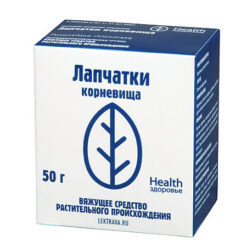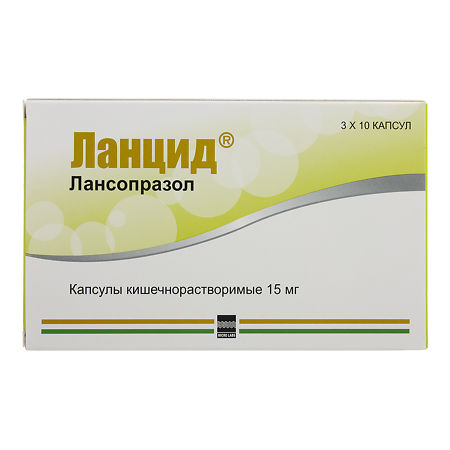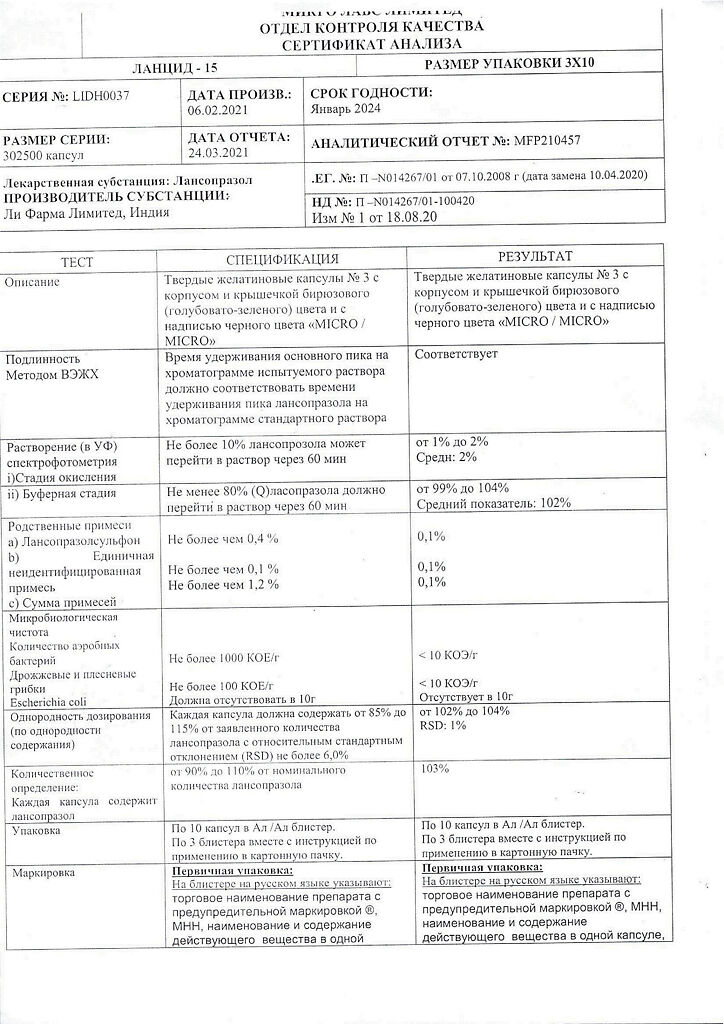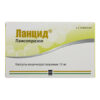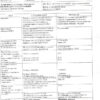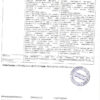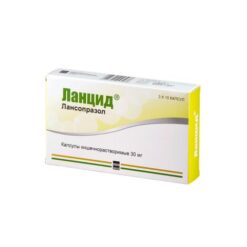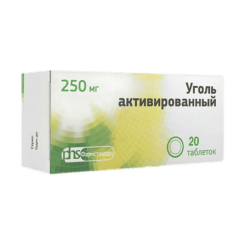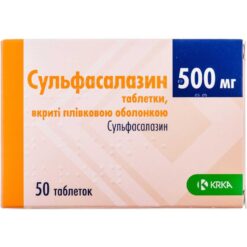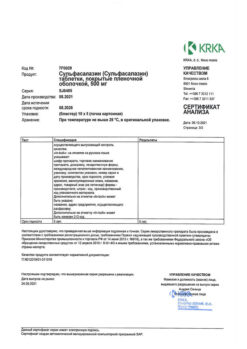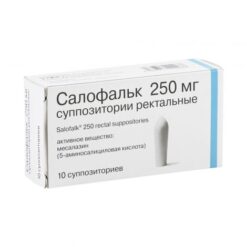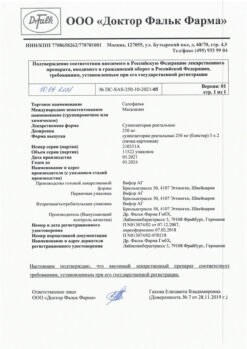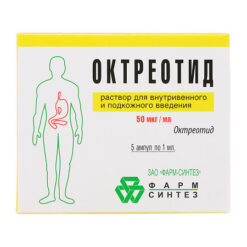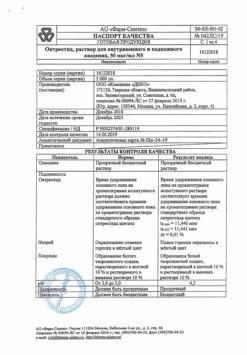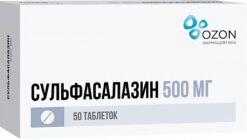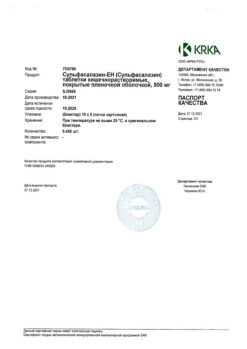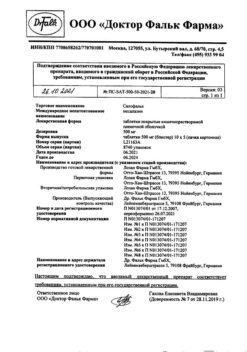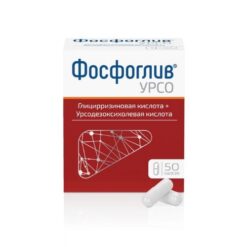Subtotal: €6.75
Lancid, 15 mg capsules 30 pcs
€13.03 €11.40
Lancid is a specific proton pump inhibitor (H+-K+-ATPase); it is metabolized in the parietal cells of the stomach to active sulfonamide derivatives, which inactivate the H+-K+-ATPase. Blocks the final stage of hydrochloric acid secretion, reducing basal and stimulated secretion, regardless of the nature of the stimulant. Having high lipophilicity it easily penetrates into the parietal cells of the stomach, concentrates in them and exerts cytoprotective effect, increasing the oxygenation of the gastric mucosa and increasing the secretion of hydrocarbonate.
The rate and degree of inhibition of basal and stimulated hydrochloric acid secretion are dose-dependent: pH begins to increase 1-2 h and 2-3 h after taking 15 and 30 mg, respectively; inhibition of hydrochloric acid production at a dose of 30 mg is 80-97%. There is no effect on gastrointestinal motility. Inhibitory effect increases during the first 4 days of use. After discontinuation of the dose acidity remains below 50% of the basal level for 39 hours, “ricochet” increase in secretion is not observed. Secretory activity normalizes 3-4 days after discontinuation of the drug.
In patients with Zollinger-Ellison syndrome the action is longer. Promotes the formation of specific IgA to Helicobacter pylori in the gastric mucosa, inhibiting their growth, increases the anti-Helicobacter activity of other drugs. Increases the concentration of pepsinogen in blood serum and inhibits the production of pepsin. Inhibition of secretion is accompanied by an increase in the number of nitrosobacteria and an increase in the concentration of nitrates in the gastric secretion. It is effective in treatment of gastric and duodenal ulcers resistant to histamine H2-receptor blockers. It provides faster healing of duodenal ulcers (85% of duodenal ulcers heal in 4 weeks of treatment at the dose of 30 mg/day).
After the first dose of lansoprazole at a dose of 30 mg, the pH of gastric juice increases in 1-2 hours. When taking the drug several times a day (30 mg) an increase in gastric juice pH is noted in the first hour after intake. The duration of action is more than 24 hours. No risk of increased gastric acidity after discontinuation of lansoprazole has been observed. The recovery of hydrochloric acid secretion to normal levels occurs gradually over a period of 2 to 4 days after several doses of the drug.
Pharmacokinetics:
Absorption
Absorption of lansoprazole begins as soon as the drug leaves the stomach. The absorption rate is high and Cmax in plasma is reached after 1.7 h, which is combined with a high bioavailability of more than 80%. Food intake reduces absorption and bioavailability (by 50%), but the inhibitory effect on gastric secretion remains the same, regardless of food intake. Such parameters of lansoprazole pharmacokinetics as Cmax and AUC are approximately proportional. If the drug is taken 30 min after a meal, both pharmacokinetics are reduced by 50%. Food has no pronounced effect if the drug is taken before meals.
Distribution
Binding to plasma proteins is 97.7-99.4%. Lansoprazole penetrates well into the tissues, including the lining cells of the stomach. Vd – 0.5 l/kg.
Metabolism
Lansoprazole is metabolized in the liver. Two metabolites (sulfinyl hydroxylate and sulfone derivative), which are inactive, are found in significant amounts in plasma. In the acidic environment of the parietal tubules lansoprazole is transformed into 2 active substances that are not detectable in the systemic blood flow.
Elimination
T1/2 of lansoprazole is less than 2 hours, which does not affect the duration of suppression of gastric secretion. It is excreted as lansoprazole sulfone and hydroxylansoprazole with bile (2/3), with urine – 14-23%.
Pharmacokinetics in special clinical cases
In liver cirrhosis, absorption may be delayed.
Renal insufficiency does not significantly affect the rate and amount of excretion. In patients with impaired renal function the protein binding may be reduced by 1-1.5%.
Indications
– peptic ulcer of the stomach and duodenum (in the acute phase);
– erosive-ulcerative esophagitis;
– reflux esophagitis;
— Zollinger-Ellison syndrome;
– stress ulcers of the gastrointestinal tract;
– non-ulcer dyspepsia.
Pharmacological effect
Lancid is a specific inhibitor of the proton pump (H+-K+-ATPase); metabolized in the parietal cells of the stomach to active sulfonamide derivatives, which inactivate H+-K+-ATPase. Blocks the final stage of hydrochloric acid secretion, reducing basal and stimulated secretion, regardless of the nature of the stimulus. Possessing high lipophilicity, it easily penetrates into the parietal cells of the stomach, concentrates in them and has a cytoprotective effect, increasing oxygenation of the gastric mucosa and increasing the secretion of bicarbonate.
The rate and degree of inhibition of basal and stimulated secretion of hydrochloric acid are dose-dependent: pH begins to increase 1-2 hours and 2-3 hours after taking 15 and 30 mg, respectively; inhibition of hydrochloric acid production when taken at a dose of 30 mg is 80-97%. Does not affect gastrointestinal motility. The inhibitory effect increases in the first 4 days of administration. After stopping the intake, acidity remains below 50% of the basal level for 39 hours, and there is no “rebound” increase in secretion. Secretory activity normalizes 3-4 days after stopping the drug.
In patients with Zollinger-Ellison syndrome, the effect lasts longer. Promotes the formation of specific IgA to Helicobacter pylori in the gastric mucosa, suppressing their growth, and increases the anti-Helicobacter activity of other drugs. Increases the concentration of pepsinogen in the blood serum and inhibits the production of pepsin. Inhibition of secretion is accompanied by an increase in the number of nitrosobacteria and an increase in the concentration of nitrates in gastric secretions. Effective in the treatment of gastric and duodenal ulcers resistant to histamine H2 receptor blockers. Provides faster healing of ulcerative defects in the duodenum (85% of duodenal ulcers heal after 4 weeks of treatment at a dose of 30 mg/day).
After the first dose of lansoprazole at a dose of 30 mg, the pH of the gastric juice increases after 1-2 hours. When taking the drug several times a day (30 mg), an increase in the pH of the gastric juice is noted in the first hour after administration. Duration of action is more than 24 hours. No risk of increased gastric acidity was observed after discontinuation of lansoprazole. The level of hydrochloric acid secretion is restored to normal gradually over a period of 2 to 4 days after taking several doses of the drug.
Pharmacokinetics:
Suction
Absorption of lansoprazole begins as soon as the drug leaves the stomach. The rate of absorption is high and Cmax in plasma is reached after 1.7 hours, which is combined with a high degree of bioavailability of more than 80%. Food intake reduces absorption and bioavailability (by 50%), but the inhibitory effect on gastric secretion remains the same, regardless of food intake. The pharmacokinetics of lansoprazole such as Cmax and AUC are approximately proportional. If the drug is taken 30 minutes after a meal, both pharmacokinetic parameters are reduced by 50%. Food does not have any significant effect if the drug is taken before meals.
Distribution
Plasma protein binding – 97.7-99.4%. Lansoprazole penetrates well into tissues, incl. into the parietal cells of the stomach. Vd – 0.5 l/kg.
Metabolism
Lansoprazole is metabolized in the liver. Two metabolites (sulfinyl hydroxylate and sulfone derivative) that are inactive are found in significant quantities in plasma. In the acidic environment of the parietal cell tubules, lansoprazole is transformed into 2 active substances that are not detectable in the systemic circulation.
Removal
T1/2 of lansoprazole is less than 2 hours, which does not affect the duration of suppression of gastric secretion. Excreted from the body in the form of lansoprazole sulfone and hydroxylansoprazole with bile (2/3), with urine – 14-23%.
Pharmacokinetics in special clinical situations
In liver cirrhosis, absorption may be slow.
Renal failure does not significantly affect the rate and amount of excretion. In patients with impaired renal function, protein binding may be reduced by 1-1.5%.
Special instructions
Before and after treatment, endoscopic monitoring is required to exclude malignant neoplasms, because treatment may mask symptoms and delay correct diagnosis.
Active ingredient
Lansoprazole
Composition
1 capsule:
– lansoprazole 15 mg
Excipients:
mannitol – 129.7 mg,
lactose monohydrate – 13 mg,
sucrose – 16.6 mg,
povidone – 3.5 mg,
hypromellose phthalate – 18.2 mg,
cetyl alcohol – 2 mg.
Composition of the capsule body:
gelatin – 24.7626 mg, sodium lauryl sulfate – 0.024 mg, propyl parahydroxybenzoate – 0.24 mg, methyl parahydroxybenzoate – 0.06 mg, titanium dioxide – 0.5557 mg, brilliant blue dye – 0.0034 mg, quinoline yellow dye – 0.0042 mg, water – 4.35 mg.
Composition of the capsule cap:
gelatin – 16.5084 mg, sodium lauryl sulfate – 0.016 mg, propyl parahydroxybenzoate – 0.04 mg, methyl parahydroxybenzoate – 0.16 mg, titanium dioxide – 0.3705 mg, brilliant blue dye – 0.0022 mg, quinoline yellow dye – 0.0028 mg, water – 2.9 mg.
Contraindications
— malignant neoplasms of the gastrointestinal tract;
— I trimester of pregnancy;
– lactation period;
– hypersensitivity to the components of the drug Lancid.
The drug should be prescribed with caution in case of liver failure, in the II-III trimesters of pregnancy, in elderly patients and patients under the age of 18 years.
Side Effects
From the digestive system: less often – increased or decreased appetite, nausea, abdominal pain; rarely – diarrhea or constipation; in some cases – ulcerative colitis, gastrointestinal candidiasis, increased activity of liver transaminases (ALT, AST), GGT, alkaline phosphatase and LDH, hyperbilirubinemia.
From the nervous system: headache; rarely – malaise, dizziness, drowsiness, depression, anxiety.
From the respiratory system: rarely – cough, pharyngitis, rhinitis, upper respiratory tract infection, influenza-like syndrome.
From the hematopoietic organs: rarely – thrombocytopenia (with hemorrhagic manifestations); in some cases – anemia.
Allergic reactions: skin rash; in some cases – photosensitivity, exudative erythema multiforme.
Other: rarely – myalgia, alopecia.
Interaction
With simultaneous use, lansoprazole slows down the elimination of drugs metabolized in the liver by microsomal oxidation (including diazepam, phenytoin, indirect anticoagulants).
Lansoprazole reduces the clearance of theophylline by 10%.
Lansoprazole, when used simultaneously, slows down the pH-dependent absorption of drugs belonging to weak acid groups and accelerates the absorption of drugs belonging to base groups. Interferes with the absorption of ketoconazole, ampicillin, iron salts, digoxin.
Lansoprazole is compatible with ibuprofen, indomethacin, diazepam, propranolol, warfarin, oral contraceptives, phenytoin, prednisolone.
Sucralfate reduces the bioavailability of lansoprazole by 30%, so it is necessary to maintain an interval between doses of 30-40 minutes.
Antacids should be prescribed 1 hour before or 1-2 hours after taking lansoprazole, as they slow down and reduce their absorption.
Manufacturer
Micro Labs Limited, India
| Manufacturer | Micro Labs Limited, India |
|---|---|
| Medication form | capsules |
| Brand | Micro Labs Limited |
Other forms…
Related products
Buy Lancid, 15 mg capsules 30 pcs with delivery to USA, UK, Europe and over 120 other countries.

